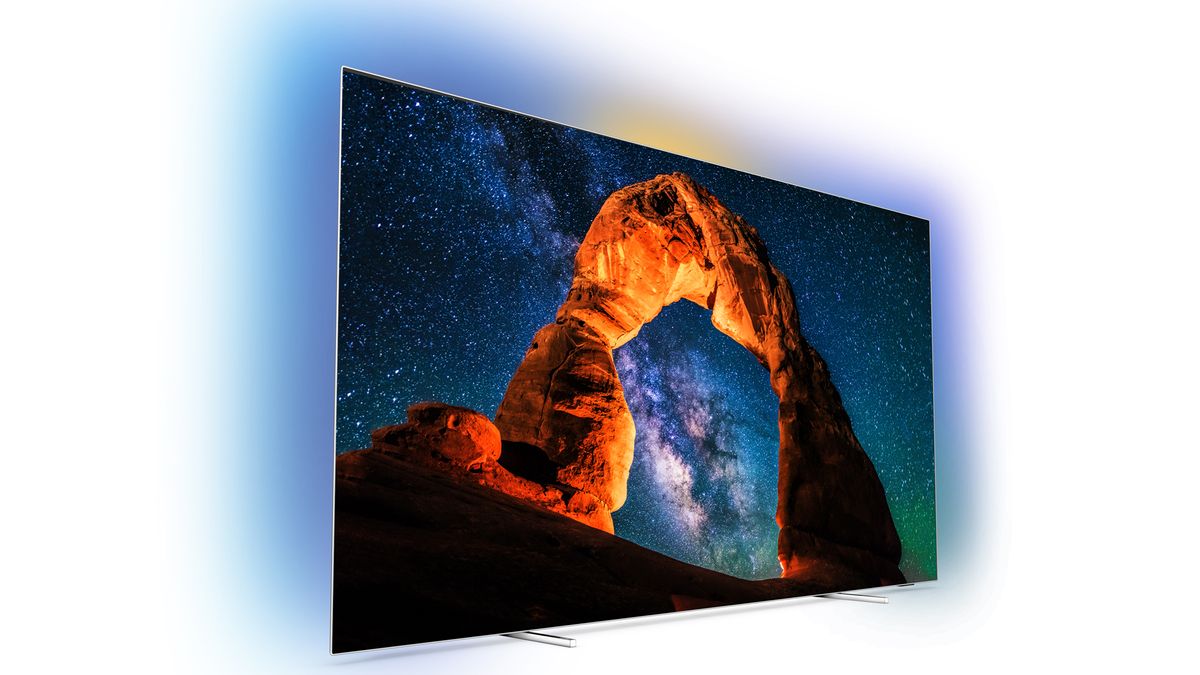TechRadar Verdict
Philips has conjured up a cracking 4K OLED screen with the 55OLED803. It does a magical job uplifting SDR content for HDR-like viewing, and delivers superb detail and contrast. Add Hue compatible Ambilight mood lighting, and you get a 4K TV with broad appeal.
Pros
- +
Superb image performance with HD and 4K
- +
Three-sided Ambilight
- +
Designer good looks
Cons
- -
No Freeview Play
- -
That Android update is long overdue
- -
Only two full-specification 4K HDMI inputs
Why you can trust TechRadar
Philips has significantly upgraded the picture processing power of its 2018 OLED TVs, and the benefits of this new found brawn can be seen writ large, with enhanced contrast and spectacular colours.
The brand’s second generation P5 Perfect Processing Engine offers twice the picture processing power of the original, and that was a pretty impressive chip in its own right.
The 803 OLED TV reviewed here is effectively second in command for the brand, positioned just below the range topping OLED 903, but beyond the latter's Bowers & Wilkins sound system, there’s little to separate them. If you already have a home cinema system ready and waiting, this could well be the smarter buy.
The 803 comes in two screen sizes: 65 inch and 55 inch (65OLED803 and 55OLED803).
- Check out the best 65-inch TVs and best 75-inch TVs
Design
- Ultra thin, minimalist appearance
- Three-sided Ambilight room lighting
- Only two full-spec 4K HDMI inputs
Cosmetic design and quality of finish are really high. The OLED 803 adopts a minimalist look, with a brushed metallic finish. The panel itself is barely 4mm thin, swelling out only to incorporate electronics and sound system.
The addition of three-sided Ambilight doesn’t add any extra width, while tiny LED lights run around the side and top of the rear protrusion.
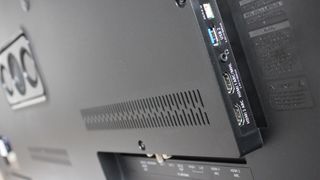
Connectivity includes four 4K capable HDMI inputs with HDCP 2.2 support, although only two are full specification 2160/60p. This shortcoming may be an issue if you don’t intend to partner the set with an AV receiver, which would obviously open the door to far wider component hook-up.
There’s two USBs and an AV minijack for composite and component hardware, while an optical audio output can be used with soundbars and audio systems. Ethernet is onboard to support the built-in Wi-Fi. There’s also a CI slot, for those looking for a set that can take an ESPN TV subscription card and the like.
The TV comes with two remotes. One is an unusually thin Bluetooth control with thumb-sized touchpad, the other a more conventional pointer, with a keypad on the reverse. I generally gravitated toward the latter, but as a piece of design the Bluetooth remote is really rather clever.
Smart TV
- Upgrade to Android Oreo promised
- Limited catch-up TV services
- Netflix, Amazon prime and YouTube all 4K capable
The smart platform of choice here is stock Android N. It may be far from our favourite smart TV platform, but at least Philips Android implementation seems more stable than Sony’s.
It also comes with the promise of an update to Oreo, the long awaited refresh which combines a more intuitive interface with Google Assistant Built-in.
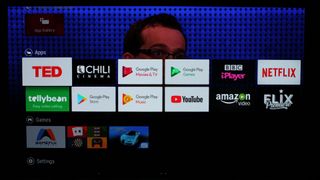
Unfortunately, a consequence of Android is that catch-up TV provision is limited. The set doesn’t use Freeview Play, so there’s no rollback TV guide, meaning no ITVHub, Demand5, UKPlay or All4. Instead the TV comes with a basic Freeview HD EPG.
Key apps include BBC iPlayer, Netflix, Amazon Prime Video, YouTube, Google Play and Rakuten TV. Both Netflix and Amazon are 4K HDR enabled, while VP9 support means YouTube is 4K capable. You can also link up the set with Alexa devices in the house to control the set remotely.
Picture performance
- Bright 2018 OLED panel
- HDR10+ upgrade promised
- Fair gaming performance
Overall image quality is excellent. The panel spec is top notch, featuring Philip’s new sub-pixel design, which boosts light output by around 10 per cent.
When it comes to HDR, the set complies with both HDR10 and Hybrid Log-Gamma (HLG) standards, and is be upgradable to HDR10+, the dynamic metadata standard jostling for position alongside rival Dolby Vision.
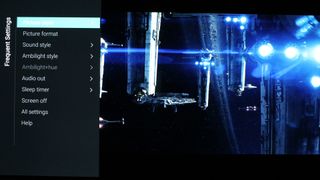
HDR10+ offers frame by frame HDR optimisation, which should lead to better shadow detail and greater colour precision with HDR10+ mastered content. Unsurprisingly, the set isn’t compatible with the competing Dolby Vision standard.
The OLED 803’s handling of everyday HDR is also excellent. Detail revealed by proprietary local contrast enhancement technology adds considerable depth to its images. Skin tones, which often don’t look quite real with HDR content, are tonally coherent, even against overly saturated backgrounds.
The set’s gaming performance is solid, without being spectacular. Play on the Standard image preset and lag is a tardy 55.4ms. Opt for the Game setting and this is trimmed to a playable 38.8ms.
- HD/SDR performance
- Perfect Natural Reality is a winner
- Wide range of image presets
Of all the set’s picture wizardry though, Perfect Natural Reality is what warrants closest inspection, because this really makes a difference with non-HDR content (be it 4K or HD).
Exclusive to Philips’ second generation P5 silicon, the Perfect Natural Reality mode uses an intelligent contrast algorithm to dynamically optimize brightness, sharpness and – of course – contrast.
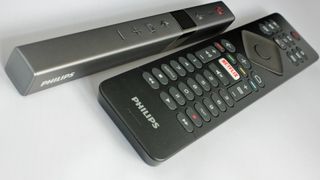
In practice, this means higher definition images, with darker shadow and lighter highlights across the colour spectrum – even a simple scene of rolling clouds becomes arresting and seems filled with drama.
Image presets comprise Personal, Vivid, Natural, Standard, Movie, Game, Monitor mode, plus ISF Day and Night – while all but Monitor mode and Day/Night upscale to HDR when fed compatible content.
For the most part, Standard and Natural are the most reliably entertaining, you may wish to experiment with the others – some vary hugely and can really affect the visual performance.
- 4K HDR performance
- Superb HDR Natural and Vivid modes
- HDR Movie mode is subjectively soft
- Motion handling a mixed bag
While the 803’s 4K HDR image presets reveal 2160p clarity, modes vary dramatically. The HDR Movie setting has no problem resolving 4K detail, but looks subjectively soft compared to HDR Natural or HDR Vivid.
The opening text crawl in Star Wars: The Last Jedi (UHD Blu-ray), when viewed in HDR Movie mode, loses half its stars. Watch in HDR Natural or HDR Vivid and they snap back.

HDR Vivid is actually a real blast. If you like your UHD to pop with detail and colour, then this mode shouldn’t be shunned.
Brightness is on par and dynamics are excellent. I measured a peak luminance of just over 830 cd/m2 (aka nits), with a 5 percent HDR window. The 803 has no problem depicting specular highlights, such as glinting headlights, bright reflections and explosive sparks.
Motion handling is more a mixed bag. The Movie motion style keeps the panel looking suitably cinematic, albeit with a low level of judder. Other options, such as Sports, Standard, Smooth and Clear, improve panning smoothness but introduce halo artefacts around moving objects. Selection is largely a matter of personal preference – while a specific ‘Personal’ setting allows you to manually adjust Perfect Natural Motion and Perfect Clear Motion settings.
Sound
- Triple ring woofer
- Powerful amplification
While the 803 lacks the high fidelity credentials of its 903 stablemate, it still offers some respectable built-in audio. A long-throw, rear triple ring woofer, supported by two passive radiators, delivers an endearing level of bass – while an oval mid-range driver, and soft dome tweeter, reinforce stereo presentation.
There’s plenty of volume too, with total output power quoted at 50W: more than enough to comfortably fill the average living room.

Other screens to shortlist
The 55OLED803 is up against some credible opposition. There’s no shortage of choice when it comes to high-performance 55-inch UHD screens.
The Sony KD-55AF8 is a strong alternative, as a set with comparable panel performance, and is the only OLED rival to offer similarly effective SDR to HDR handling. It’s also Android-based, albeit with the bonus of YouView catch-up services. You’ll pay slightly more for its superior Acoustic Surface Audio technology though.
Alternatively, consider the 55-inch LG C8. This combines a great picture performance with a 2018-fresh Alpha 9 image processor and superior AI ThinQ webOS smart platform.
Our verdict
The effectiveness of Philips second generation P5 picture engine may sometimes be subtle with real-world content, but it gives this set an edge when it comes to playing in SDR 4K or HD.
Buyers should weigh the visual benefits against the minor irritations, like poor catch-up TV provision, just two full-spec UHD HDMI inputs and the lack of Dolby Vision. Philips Hue-compatible Ambilight room lighting system, and the promise of an early upgrade to the new Android Oreo TV OS, however, might just balance the books.
With a competitive price point for the technology on offer, the 803 is arguably Philips most compelling OLED proposition to date.
- Best OLED TVs: our pick of the best OLED televisions you can buy
Steve has been writing about AV and home cinema since the dawn of time, or more accurately, since the glory days of VHS and Betamax. He has strong opinions on the latest TV technology, Hi-Fi and Blu-ray/media players, and likes nothing better than to crank up his ludicrously powerful home theatre system to binge-watch TV shows.
Most Popular


